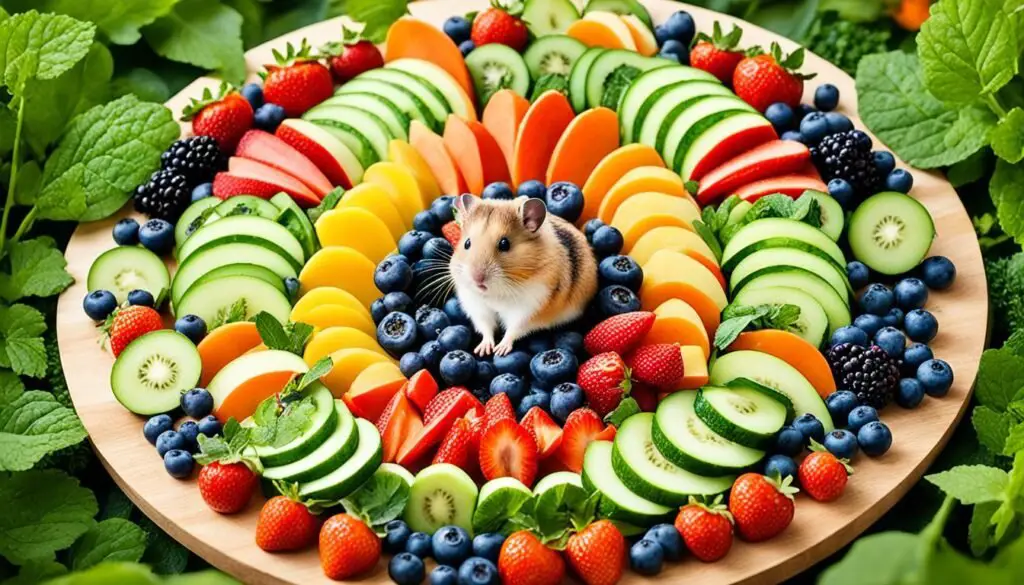Did you know that hamsters are not only fond of vegetables and pellets, but they also have a taste for insects? It’s true! Insects can be a nutritious and exciting addition to your hamster’s diet. They provide essential protein and natural enrichment for your furry friend. So, if you’re wondering what insects can hamsters eat or looking for safe insects for hamsters, you’ve come to the right place! Here, we’ll explore the world of insects as hamster food and discover some edible insects that your hamster will love.
The Ideal Hamster Diet
When it comes to your hamster’s diet, it’s essential to provide them with a well-rounded and balanced meal plan. The ideal hamster diet consists of a combination of commercial hamster pellets, fresh fruit and vegetables, and occasional treats. Here’s a breakdown of what you should include in your hamster’s daily menu:
- Commercial Hamster Pellets: Opt for high-quality commercial hamster pellets instead of muesli-style mix. These pellets are specifically formulated to meet your hamster’s nutritional needs and help promote overall health and well-being.
- Fresh Fruit and Vegetables: Supplement your hamster’s diet with small amounts of fresh fruits and vegetables. Good options include apple slices, carrot sticks, cucumber slices, and leafy greens like spinach or kale.
- Mealworms: Hamsters love mealworms, and they are an excellent source of protein. Offer them as occasional treats to add variety to your hamster’s diet and provide essential nutrients.
In addition to the main components of your hamster’s diet, it’s crucial to provide them with constant access to clean, fresh water. Make sure to refill their water bottle regularly and keep an eye on any signs of dehydration.
To make feeding time more enjoyable and engaging for your hamster, consider scattering food pellets around their cage or hiding them inside paper bags or cardboard tubes. This not only provides mental stimulation but also helps prevent boredom.
By following this ideal hamster diet, you can ensure that your furry friend receives all the necessary nutrients for a healthy and happy life.
Healthy Fruit, Vegetables, and Herbs for Hamsters
When it comes to maintaining your hamster’s health and well-being, providing a balanced and nutritious diet is essential. Including a variety of hamster-friendly fruits, vegetables, and herbs in their diet not only adds flavor and variety but also ensures they receive the necessary vitamins and minerals for optimal health.
Fruits: Some suitable fruits for hamsters include apple, pear, peach, and melon. These fruits are not only tasty but also provide essential nutrients. However, it is important to avoid feeding them citrus fruits like oranges, lemons, or grapefruits, as they can cause digestive issues in hamsters.
Vegetables: Hamsters can consume a wide range of vegetables. Carrot, broccoli, cabbage, cauliflower, spinach, sweet peppers, cucumber, cress, and courgette are all safe choices. These vegetables not only provide important vitamins and minerals but also add crunchy texture to your hamster’s diet.
Herbs: Adding herbs to your hamster’s diet can offer aromatic flavors and potential health benefits. Some safe herbs for hamsters include basil, sage, parsley, and coriander. These herbs not only enhance the taste of their food but also provide natural antioxidants that support their immune system.
It is important to wash fruits, vegetables, and herbs thoroughly before feeding them to your hamster. This helps remove any pesticides or dirt that may be present. Additionally, remember to provide these foods in small amounts each day, as overfeeding can lead to digestive issues. By incorporating a variety of hamster-friendly fruits, vegetables, and herbs into their diet, you can ensure your furry friend receives a well-rounded and nutritious meal every day.
Chew and Gnaw Toys for Hamsters
Hamsters have a natural behavior of chewing and gnawing, which helps keep their teeth healthy and prevents overgrowth. Providing them with suitable chew and gnaw toys is essential for their overall dental health and well-being.
Safe Chew Toys for Hamsters
- Cardboard: Hamsters love to chew on cardboard tubes and boxes. You can provide them with empty toilet paper rolls or small cardboard boxes that they can explore and chew on.
- Coconut Shells: Empty coconut shells can make excellent chew toys for hamsters. They provide a natural and safe material for them to gnaw on.
- Hay Cubes: Hay cubes offer both a source of nutrition and a way for hamsters to keep their teeth in check. Make sure the hay cubes are all-natural and free from any additives.
- Unbleached Loofah: Unbleached loofah can be a great addition to your hamster’s cage. They can chew on it, hide in it, and have a lot of fun with this chew toy.
- Pumice Stone: Pumice stone is a natural lava rock that hamsters can chew on. It helps to wear down their teeth and keeps them from becoming too long.
- Seagrass: Seagrass balls or mats are another safe and natural option for hamsters to chew on. They provide a textured surface for them to gnaw and explore.
Natural Chew Toys for Hamsters
Aside from the toys mentioned above, hamsters can also gnaw on untreated softwood branches. Some suitable options include apple, dogwood, elm, grape, hawthorn, hazelnut, pear, poplar, quince, willow, and yucca. Before giving them softwood branches, it is important to bake them on low heat for an hour and wash them to ensure they are safe for your hamster.
It’s crucial to regularly inspect the chew toys to ensure they’re free from any loose splinters or hazards. Remove any damaged or worn-out toys to prevent any harm to your hamster. Providing a variety of safe chew and gnaw toys will not only keep your hamster entertained but also support their dental health.
Pelleted Foods for Hamsters
Pelleted hamster foods provide a completely balanced diet in every bite and are often recommended for their nutrient content. These pellets come in various shapes and are made to resemble small biscuits, cookies, or cereal. Hamsters find them palatable, making it easier to ensure they receive all the necessary nutrients they need.
When choosing hamster pellets, look for ones specifically formulated for hamsters. These pellets are designed to meet their nutritional requirements, including the right balance of carbohydrates, proteins, fats, vitamins, and minerals. They also help wear down hamsters’ continuously growing teeth, reducing the risk of dental problems.
Feeding hamsters a pelleted diet ensures that they receive a consistent and balanced intake of essential nutrients in each meal. This helps prevent selective eating, which can occur when hamsters are given a variety of food options and may only choose their favorite items, missing out on important nutrients.
It is important to supplement the pelleted diet with other tastier foods to prevent hamsters from becoming choosy. Offering a variety of fresh fruits, vegetables, and occasional treats like mealworms can provide additional texture and flavor to their diet, promoting overall satisfaction and enrichment.
Ensure that you carefully follow the feeding guidelines provided on the pellet package. Hamsters should typically be offered a few tablespoons of pellets each day, adjusting the portion size based on their age, size, and activity level. Additionally, make sure fresh water is always available for your hamster to stay hydrated.
By incorporating pelleted foods into your hamster’s diet, you can ensure they receive a well-balanced and nutritionally complete meal in every bite, promoting their overall health and well-being.

Seed Mixes for Hamsters
When it comes to hamster seed mixes, variety is key. Hamsters absolutely love a mixture of seeds, but they have a tendency to pick through and find their favorites, leaving the rest untouched. To provide a balanced diet for your furry friend, it’s best to combine pellets and loose seeds or choose a seed blend that includes some pellets.
A good hamster seed mix consists of a combination of grains, seeds, and dried vegetables or fruits, with added vitamins and minerals. It’s important to ensure that the seed mix you choose is specifically formulated for hamsters and not for other types of rodents or birds.
Feeding your hamster the right amount of seed mix is essential. The recommended daily quantity is around 1/8-cup. This ensures that your hamster gets all the essential nutrients without overindulging in fatty and sugary foods.
Including seed mixes as part of your hamster’s diet not only provides them with a tasty treat but also stimulates their natural foraging instincts. Watching your hamster search for their favorite seeds and munch away is a delightful experience. However, it’s essential to remember that seed mixes should not be the sole component of your hamster’s diet. It should be complemented with other foods, such as fresh fruits, vegetables, and pellets to ensure a balanced and nutritious meal.
Fresh Foods for Hamsters
Hamsters enjoy a varied diet that includes fresh vegetables and fruits. These fresh foods should make up about 20% of their overall diet to ensure a balanced and healthy meal plan. Adding fresh produce to your hamster’s diet provides them with essential vitamins and minerals, as well as a refreshing change from their regular food.
When selecting fresh foods for your hamster, it is important to choose items that are safe and beneficial for their health. Some hamster-friendly fruits and vegetables include kale, dandelion greens, romaine lettuce, Swiss chard, raw spinach, and apples. Bananas, berries, grapes, and melons are also great choices to include in your hamster’s diet.
To offer fresh foods to your hamster, wash them thoroughly to remove any pesticides or dirt. Cut the fruits and vegetables into small, bite-sized pieces that are easy for your hamster to eat. It is recommended to offer a small amount of fresh, clean produce to your hamster each day and remove any uneaten food by the end of the day to prevent spoiling.

Foods to Avoid for Hamsters
When it comes to feeding your hamster, there are certain foods that should be avoided as they can be toxic to their health. These foods include apple seeds, raw beans, raw potatoes, almonds (in large quantities), citrus fruits, garlic, onions, rhubarb leaves or raw rhubarb, chocolate (in large quantities), sugary or salty foods, junk food, and red meat.
Apple seeds contain cyanide, which is harmful to hamsters if ingested. Raw beans and raw potatoes contain toxins that can cause digestive issues. Almonds should be fed in moderation due to their high fat content, and citrus fruits can irritate their sensitive digestive system. Garlic and onions can lead to anemia in hamsters, while rhubarb leaves and raw rhubarb contain oxalic acid, which can be toxic.
Chocolate, sugary or salty foods, and junk food should be strictly avoided. These foods are not nutritious and can lead to obesity and other health problems in hamsters. Additionally, hamsters are not designed to digest red meat, so it’s best to steer clear of feeding them any kind of meat.
By being aware of these foods to avoid, you can ensure the health and well-being of your beloved hamster. Stick to a balanced diet of hamster-friendly foods and consult with a veterinarian if you have any concerns about your pet’s diet.
